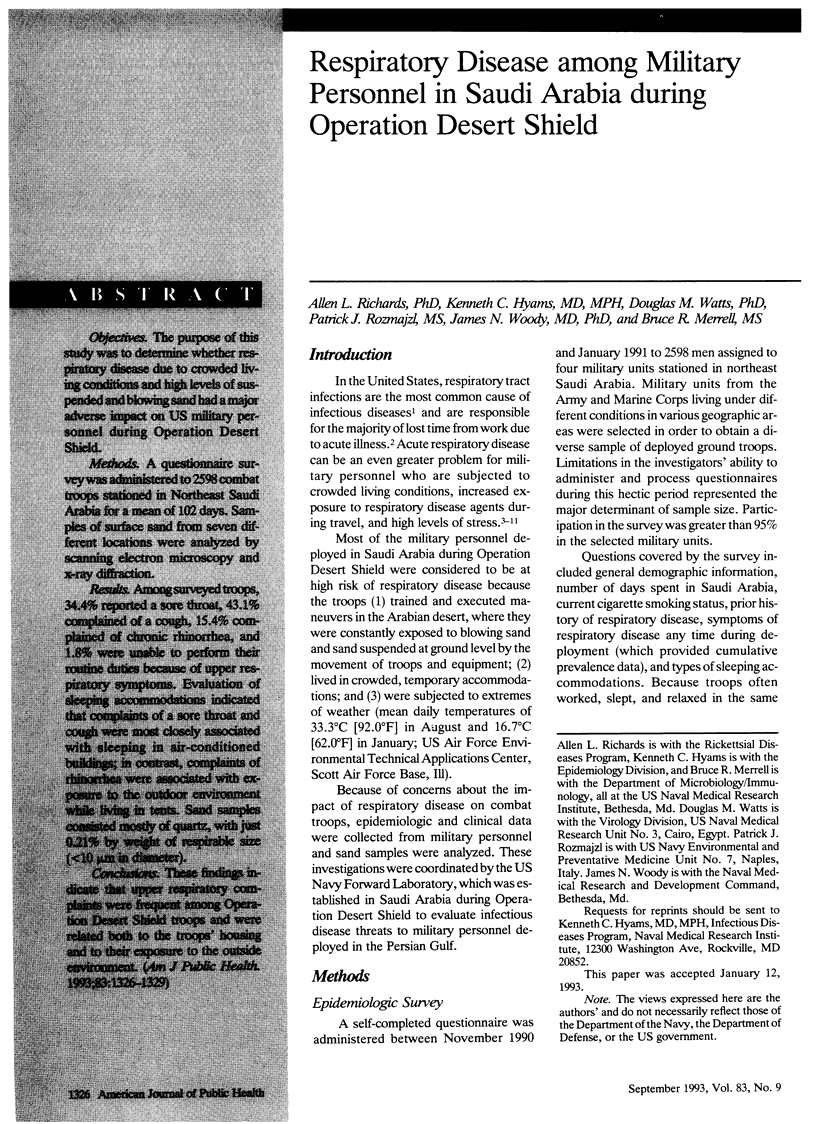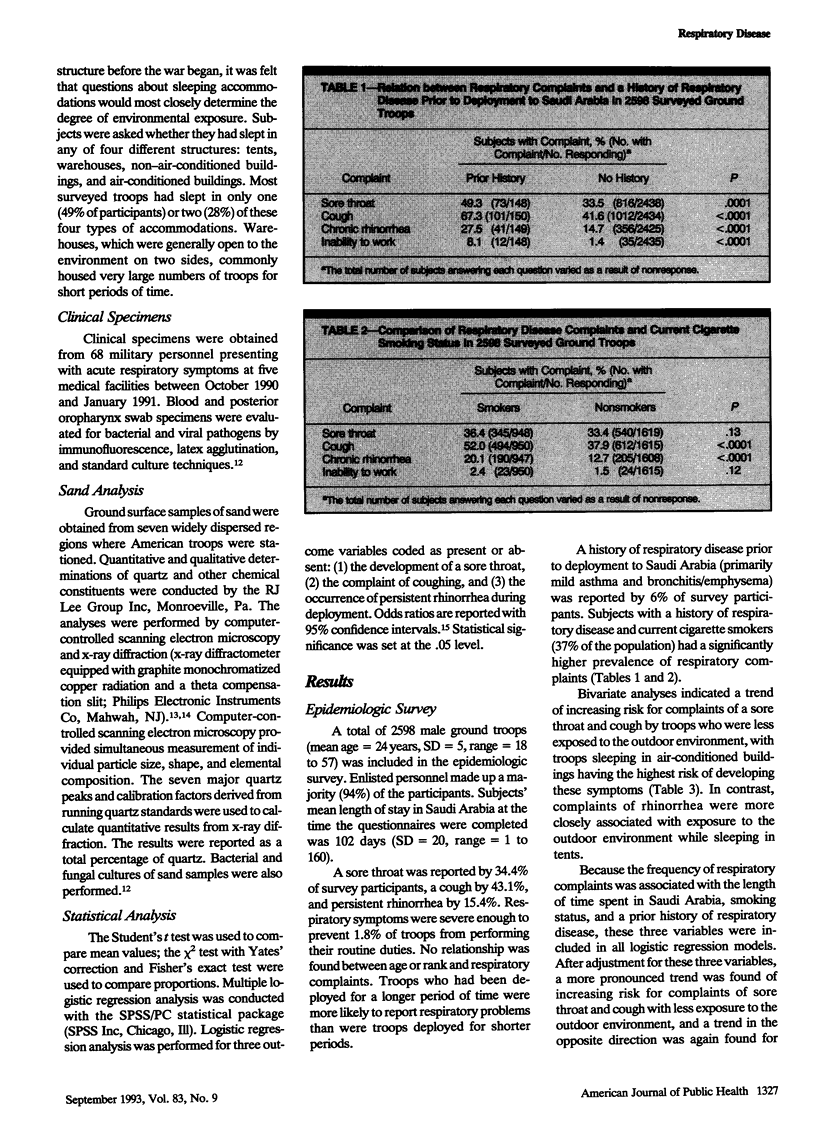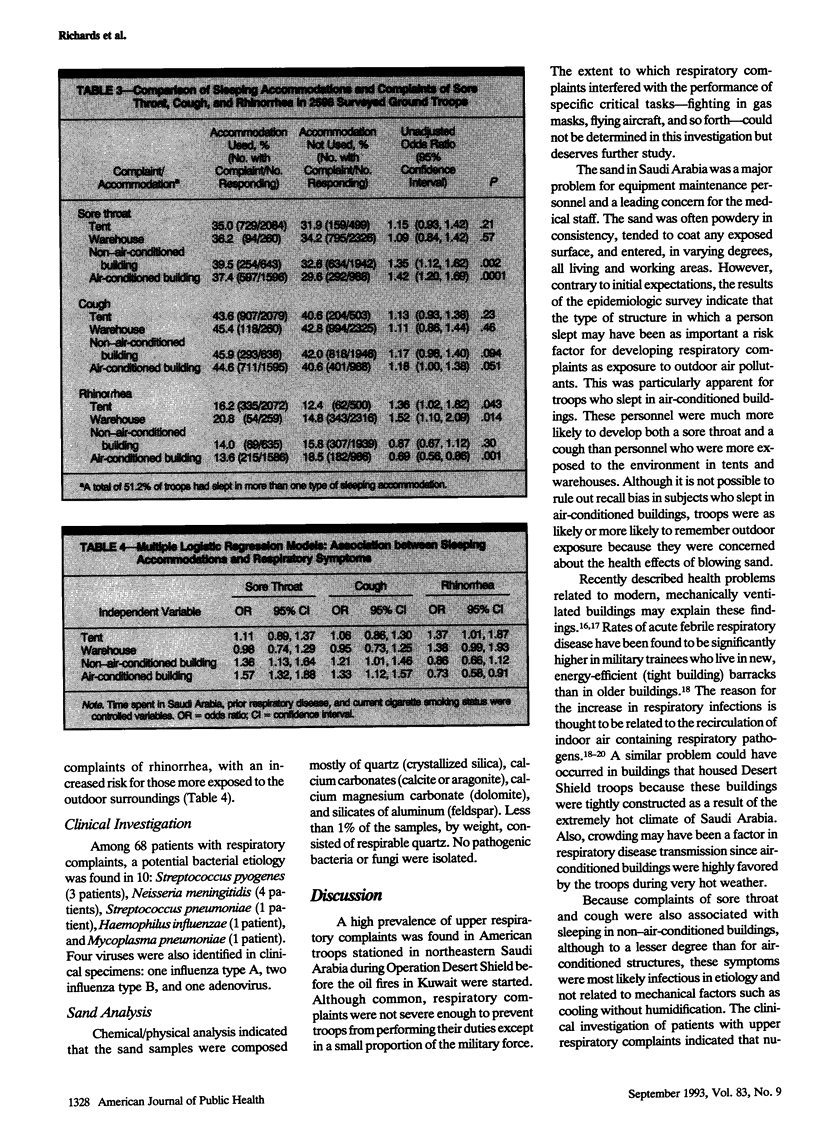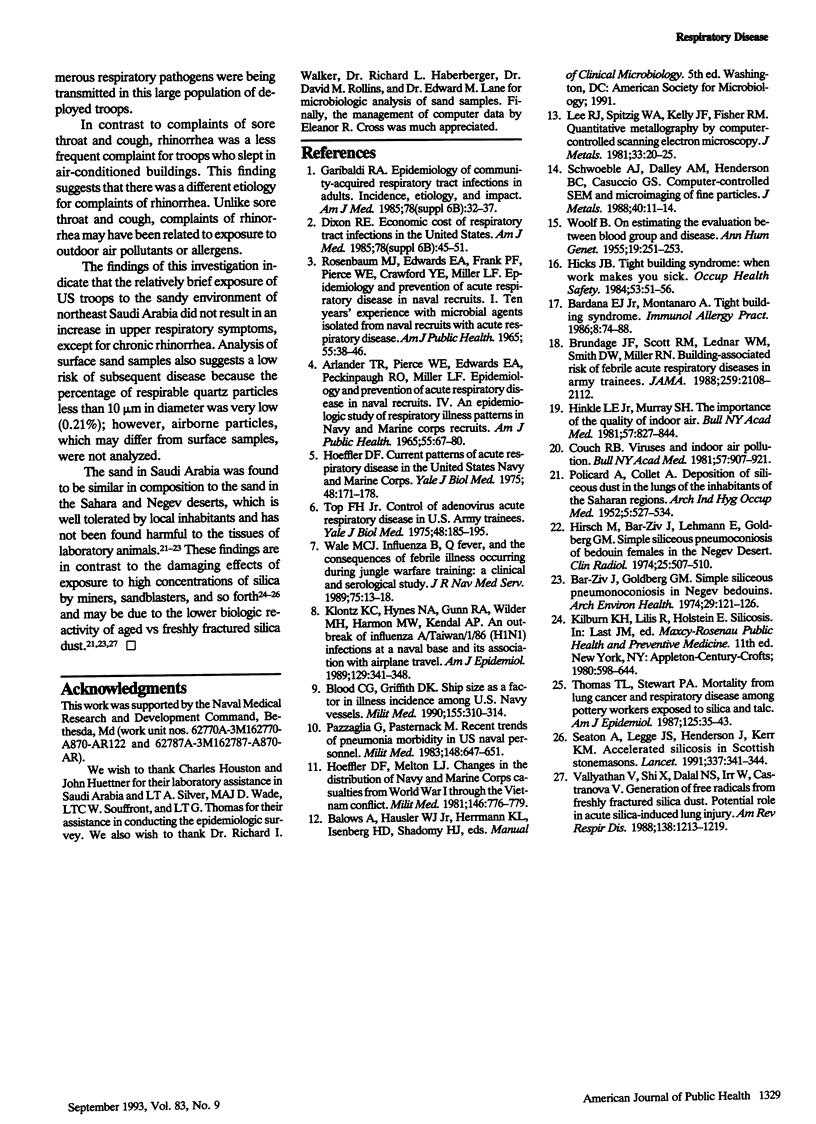Abstract
OBJECTIVES. The purpose of this study was to determine whether respiratory disease due to crowded living conditions and high levels of suspended and blowing sand had a major adverse impact on US military personnel during Operation Desert Shield. METHODS. A questionnaire survey was administered to 2598 combat troops stationed in Northeast Saudi Arabia for a mean of 102 days. Samples of surface sand from seven different locations were analyzed by scanning electron microscopy and x-ray diffraction. RESULTS. Among surveyed troops, 34.4% reported a sore throat, 43.1% complained of a cough, 15.4% complained of chronic rhinorrhea, and 1.8% were unable to perform their routine duties because of upper respiratory symptoms. Evaluation of sleeping accommodations indicated that complaints of a sore throat and cough were most closely associated with sleeping in air-conditioned buildings; in contrast, complaints of rhinorrhea were associated with exposure to the outdoor environment while living in tents. Sand samples consisted mostly of quartz, with just 0.21% by weight of respirable size (< 10 microns in diameter). CONCLUSIONS. These findings indicate that upper respiratory complaints were frequent among Operation Desert Shield troops and were related both to the troops' housing and to their exposure to the outside environment.
Full text
PDF



Selected References
These references are in PubMed. This may not be the complete list of references from this article.
- ARLANDER T. R., PIERCE W. E., EDWARDS E. A., PECKINPAUGH R. O., MILLER L. F. EPIDEMIOLOGY AND PREVENTION OF ACUTE RESPIRATORY DISEASE IN NAVAL RECRUITS.IV. AN EPIDEMIOLOGIC STUDY OF RESPIRATORY ILLNESS PATTERNS IN NAVY AND MARINE CORPS RECRUITS. Am J Public Health Nations Health. 1965 Jan;55:67–80. doi: 10.2105/ajph.55.1.67. [DOI] [PMC free article] [PubMed] [Google Scholar]
- Bar-Ziv J., Goldberg G. M. Simple siliceous pneumoconiosis in Negev Bedouins. Arch Environ Health. 1974 Sep;29(3):121–126. doi: 10.1080/00039896.1974.10666548. [DOI] [PubMed] [Google Scholar]
- Blood C. G., Griffith D. K. Ship size as a factor in illness incidence among U.S. Navy vessels. Mil Med. 1990 Jul;155(7):310–314. [PubMed] [Google Scholar]
- Brundage J. F., Scott R. M., Lednar W. M., Smith D. W., Miller R. N. Building-associated risk of febrile acute respiratory diseases in Army trainees. JAMA. 1988 Apr 8;259(14):2108–2112. [PubMed] [Google Scholar]
- Couch R. B. Viruses and indoor air pollution. Bull N Y Acad Med. 1981 Dec;57(10):907–921. [PMC free article] [PubMed] [Google Scholar]
- Dixon R. E. Economic costs of respiratory tract infections in the United States. Am J Med. 1985 Jun 28;78(6B):45–51. doi: 10.1016/0002-9343(85)90363-8. [DOI] [PubMed] [Google Scholar]
- Garibaldi R. A. Epidemiology of community-acquired respiratory tract infections in adults. Incidence, etiology, and impact. Am J Med. 1985 Jun 28;78(6B):32–37. doi: 10.1016/0002-9343(85)90361-4. [DOI] [PMC free article] [PubMed] [Google Scholar]
- Hicks J. B. Tight building syndrome: when work makes you sick. Occup Health Saf. 1984 Jan;:51–56. [PubMed] [Google Scholar]
- Hinkle L. E., Jr, Murray S. H. The importance of the quality of indoor air. Bull N Y Acad Med. 1981 Dec;57(10):827–844. [PMC free article] [PubMed] [Google Scholar]
- Hirsch M., Bar-Ziv J., Lehmann E., Goldberg G. M. Simple siliceous pneumoconiosis of Bedouin females in the Negev desert. Clin Radiol. 1974 Oct;25(4):507–510. doi: 10.1016/s0009-9260(74)80135-2. [DOI] [PubMed] [Google Scholar]
- Hoeffler D. F. Current patterns of acute respiratory disease in the United States Navy and Marine Corps. Yale J Biol Med. 1975 Jul;48(3):171–178. [PMC free article] [PubMed] [Google Scholar]
- Hoeffler D. F., Melton L. J., 3rd Changes in the distribution of Navy and Marine Corps casualties from World War I through the Vietnam conflict. Mil Med. 1981 Nov;146(11):776–779. [PubMed] [Google Scholar]
- Klontz K. C., Hynes N. A., Gunn R. A., Wilder M. H., Harmon M. W., Kendal A. P. An outbreak of influenza A/Taiwan/1/86 (H1N1) infections at a naval base and its association with airplane travel. Am J Epidemiol. 1989 Feb;129(2):341–348. doi: 10.1093/oxfordjournals.aje.a115137. [DOI] [PubMed] [Google Scholar]
- POLICARD A., COLLET A. Deposition of siliceous dust in the lungs of the inhabitants of the Saharan regions. AMA Arch Ind Hyg Occup Med. 1952 Jun;5(6):527–534. [PubMed] [Google Scholar]
- ROSENBAUM M. J., EDWARDS E. A., FRANK P. F., PIERCE W. E., CRAWFORD Y. E., MILLER L. F. EPIDEMIOLOGY AND PREVENTION OF ACUTE RESPIRATORY DISEASE IN NAVAL RECRUITS. I. TEN YEARS' EXPERIENCE WITH MICROBIAL AGENTS ISOLATED FROM NAVAL RECRUITS WITH ACUTE RESPIRATORY DISEASE. Am J Public Health Nations Health. 1965 Jan;55:38–46. doi: 10.2105/ajph.55.1.38. [DOI] [PMC free article] [PubMed] [Google Scholar]
- Seaton A., Legge J. S., Henderson J., Kerr K. M. Accelerated silicosis in Scottish stonemasons. Lancet. 1991 Feb 9;337(8737):341–344. doi: 10.1016/0140-6736(91)90956-p. [DOI] [PubMed] [Google Scholar]
- Thomas T. L., Stewart P. A. Mortality from lung cancer and respiratory disease among pottery workers exposed to silica and talc. Am J Epidemiol. 1987 Jan;125(1):35–43. doi: 10.1093/oxfordjournals.aje.a114510. [DOI] [PubMed] [Google Scholar]
- Top F. H., Jr Control of adenovirus acute respiratory disease in U.S. Army trainees. Yale J Biol Med. 1975 Jul;48(3):185–195. [PMC free article] [PubMed] [Google Scholar]
- Vallyathan V., Shi X. L., Dalal N. S., Irr W., Castranova V. Generation of free radicals from freshly fractured silica dust. Potential role in acute silica-induced lung injury. Am Rev Respir Dis. 1988 Nov;138(5):1213–1219. doi: 10.1164/ajrccm/138.5.1213. [DOI] [PubMed] [Google Scholar]
- WOOLF B. On estimating the relation between blood group and disease. Ann Hum Genet. 1955 Jun;19(4):251–253. doi: 10.1111/j.1469-1809.1955.tb01348.x. [DOI] [PubMed] [Google Scholar]
- Wale M. C. Influenza B, Q fever, and the consequences of febrile illness occurring during jungle warfare training: a clinical and serological study. J R Nav Med Serv. 1989 Spring;75(1):13–18. [PubMed] [Google Scholar]


